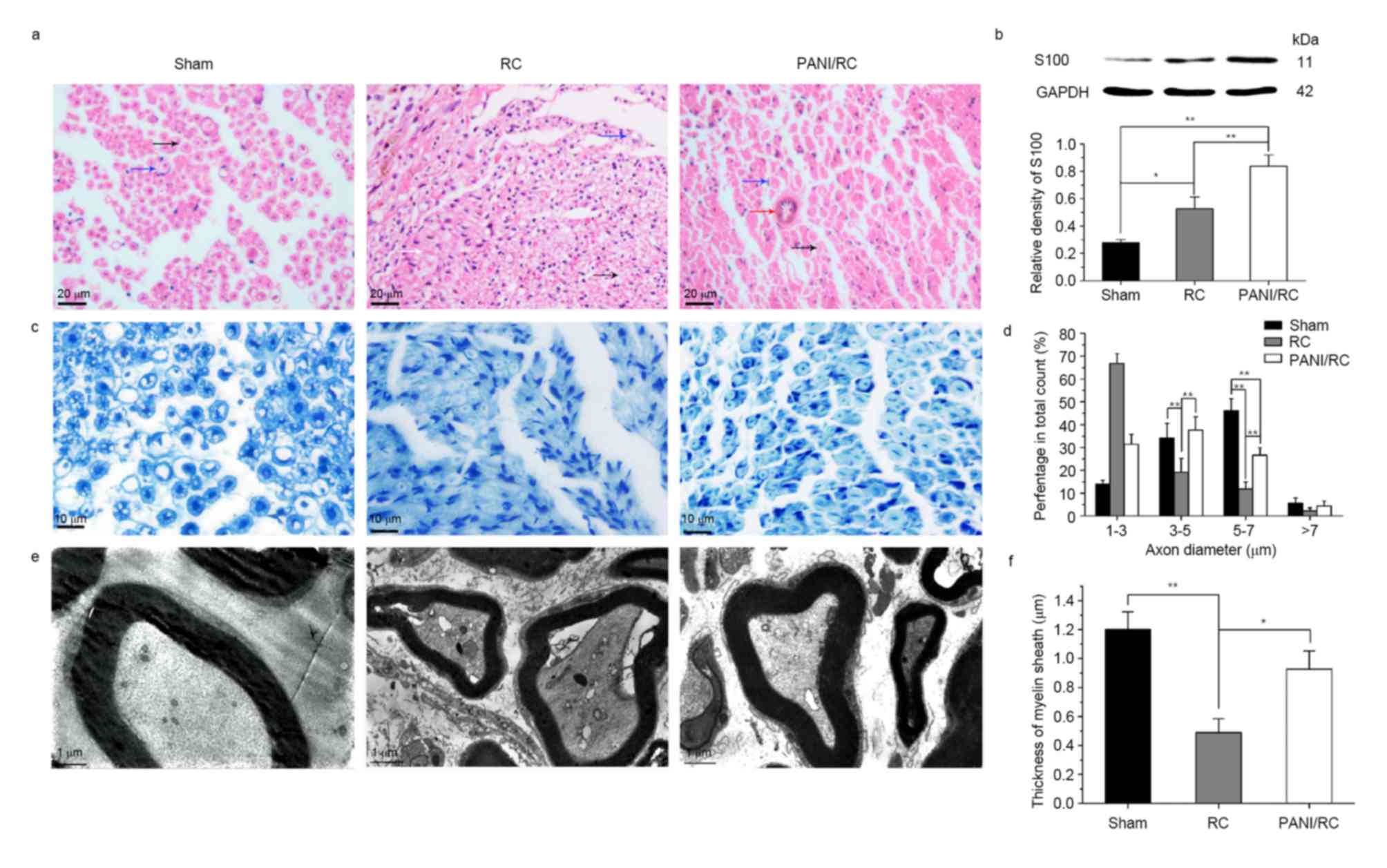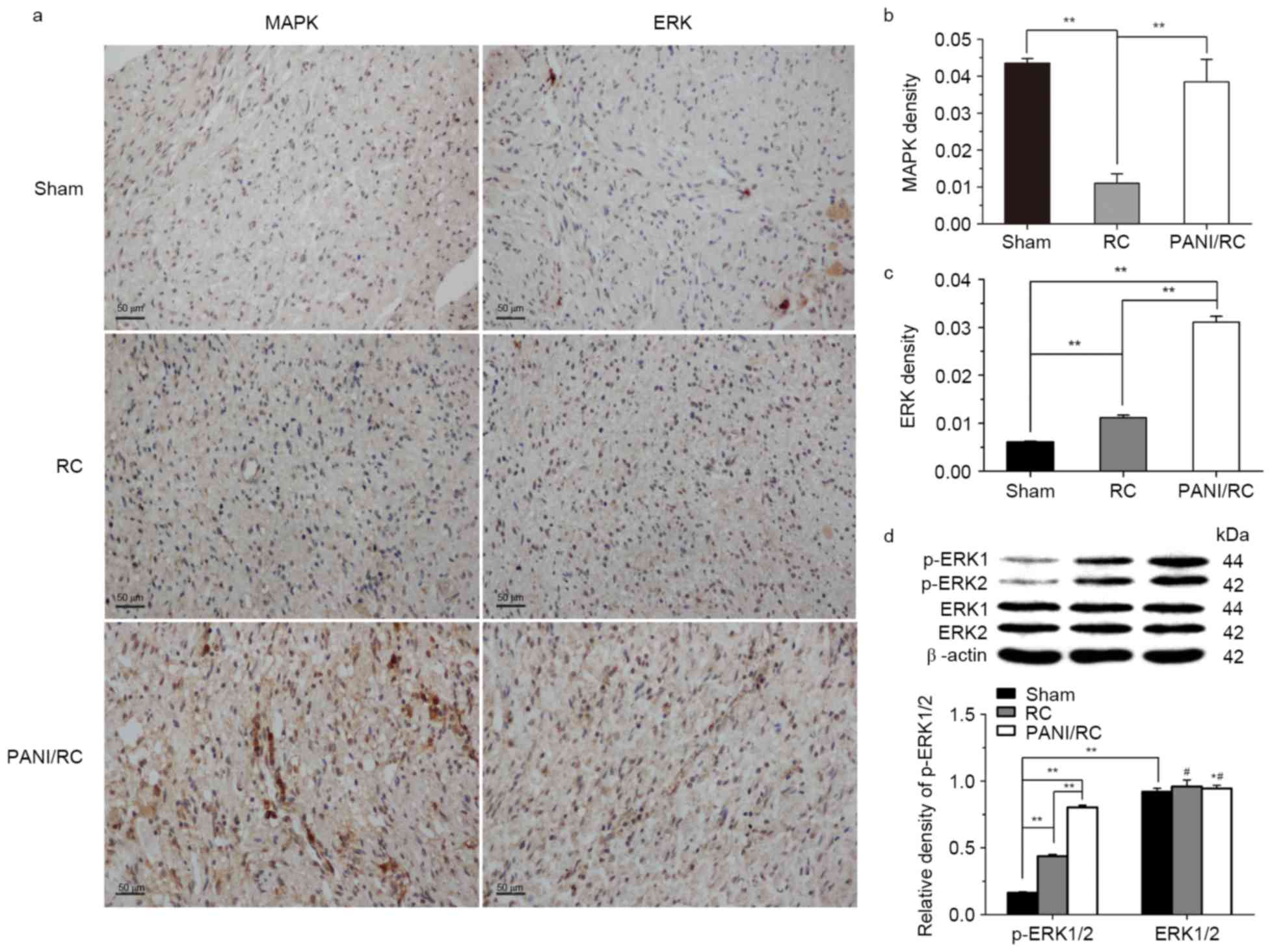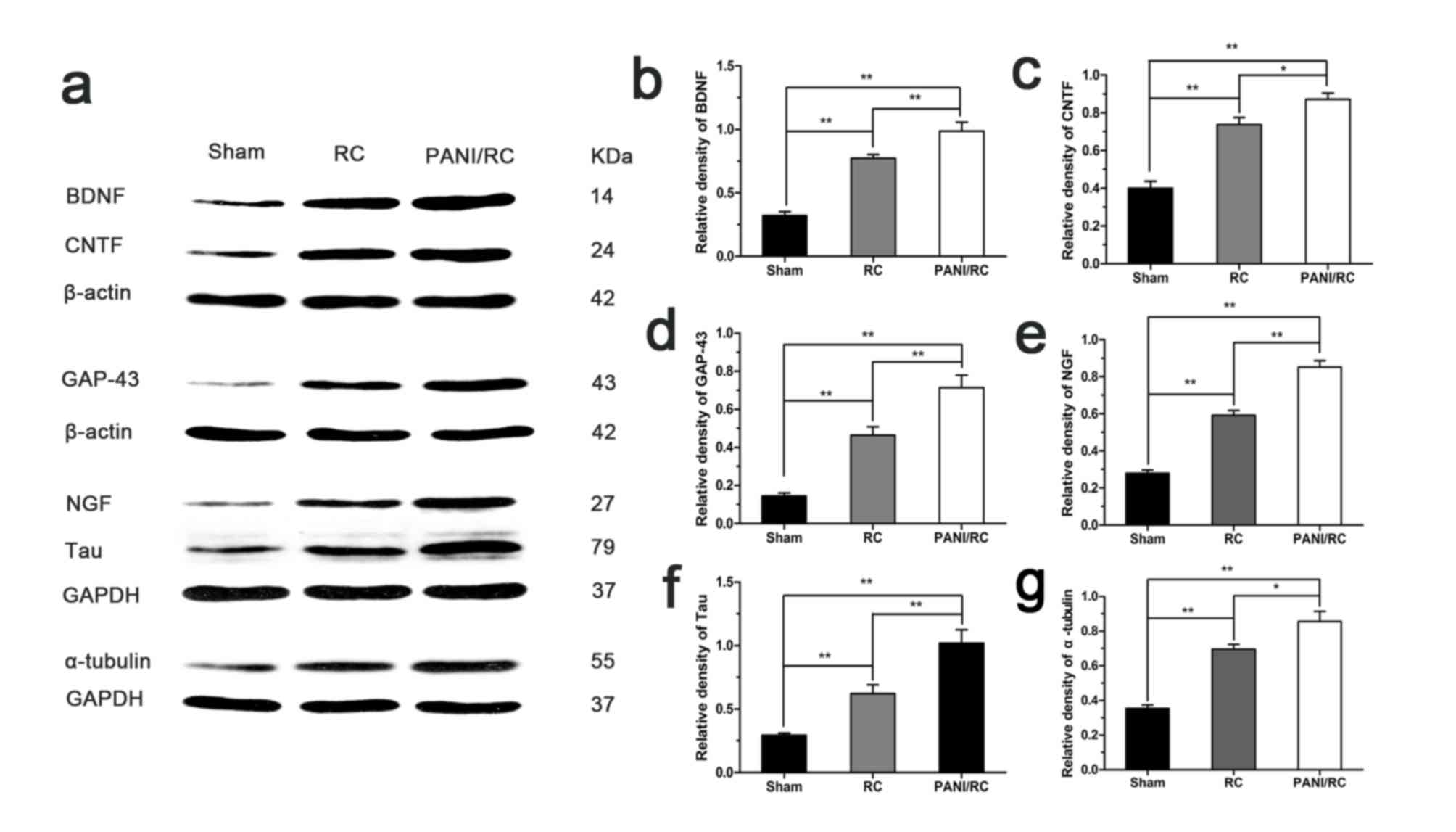|
1
|
Siemionow M and Brzezicki G: Chapter 8:
Current techniques and concepts in peripheral nerve repair. Int Rev
Neurobiol. 87:141–172. 2009. View Article : Google Scholar : PubMed/NCBI
|
|
2
|
Buchthal F and Kühl V: Nerve conduction,
tactile sensibility, and the electromyogram after suture or
compression of peripheral nerve: A longitudinal study in man. J
Neurol Neurosurg Psychiatry. 42:436–451. 1979. View Article : Google Scholar : PubMed/NCBI
|
|
3
|
Evans GR: Peripheral nerve injury: A
review and approach to tissue engineered constructs. Anat Rec.
263:396–404. 2001. View
Article : Google Scholar : PubMed/NCBI
|
|
4
|
Burnett MG and Zager EL: Pathophysiology
of peripheral nerve injury: A brief review. Neurosurg Focus.
16:E12004. View Article : Google Scholar : PubMed/NCBI
|
|
5
|
Xu D, Fan L, Gao L, Xiong Y, Wang Y, Ye Q,
Yu A, Dai H, Yin Y, Cai J and Zhang L: Micro-nanostructured
polyaniline assembled in cellulose matrix via interfacial
polymerization for applications in nerve regeneration. ACS Appl
Mater Interfaces. 8:17090–17097. 2016. View Article : Google Scholar : PubMed/NCBI
|
|
6
|
Bhatheja K and Field J: Schwann cells:
Origins and role in axonal maintenance and regeneration. Int J
Biochem Cell Biol. 38:1995–1999. 2006. View Article : Google Scholar : PubMed/NCBI
|
|
7
|
Mar FM, Bonni A and Sousa MM: Cell
intrinsic control of axon regeneration. EMBO Rep. 15:254–263. 2014.
View Article : Google Scholar : PubMed/NCBI
|
|
8
|
Makwana M and Raivich G: Molecular
mechanisms in successful peripheral regeneration. FEBS J.
272:2628–2638. 2005. View Article : Google Scholar : PubMed/NCBI
|
|
9
|
Benraiss A, Chmielnicki E, Lerner K, Roh D
and Goldman SA: Adenoviral brain-derived neurotrophic factor
induces both neostriatal and olfactory neuronal recruitment from
endogenous progenitor cells in the adult forebrain. J Neurosci.
21:6718–6731. 2001.PubMed/NCBI
|
|
10
|
Acheson A, Conover JC, Fandl JP, DeChiara
TM, Russell M, Thadani A, Squinto SP, Yancopoulos GD and Lindsay
RM: A BDNF autocrine loop in adult sensory neurons prevents cell
death. Nature. 374:450–453. 1995. View
Article : Google Scholar : PubMed/NCBI
|
|
11
|
Huang EJ and Reichardt LF: Neurotrophins:
Roles in neuronal development and function. Annu Rev Neurosci.
24:677–736. 2001. View Article : Google Scholar : PubMed/NCBI
|
|
12
|
Tom VJ, Sandrow-Feinberg HR, Miller K,
Domitrovich C, Bouyer J, Zhukareva V, Klaw MC, Lemay MA and Houlé
JD: Exogenous BDNF enhances the integration of chronically injured
axons that regenerate through a peripheral nerve grafted into a
chondroitinase-treated spinal cord injury site. Exp Neurol.
239:91–100. 2013. View Article : Google Scholar : PubMed/NCBI
|
|
13
|
Friedman B, Scherer SS, Rudge JS, Helgren
M, Morrisey D, McClain J, Wang DY, Wiegand SJ, Furth ME, Lindsay
RM, et al: Regulation of ciliary neurotrophic factor expression in
myelin-related Schwann cells in vivo. Neuron. 9:295–305. 1992.
View Article : Google Scholar : PubMed/NCBI
|
|
14
|
Zhang J, Lineaweaver WC, Oswald T, Chen Z,
Chen Z and Zhang F: Ciliary neurotrophic factor for acceleration of
peripheral nerve regeneration: An experimental study. J Reconstr
Microsurg. 20:323–327. 2004. View Article : Google Scholar : PubMed/NCBI
|
|
15
|
Cen LP, Luo JM, Zhang CW, Fan YM, Song Y,
So KF, van Rooijen N, Pang CP, Lam DS and Cui Q: Chemotactic effect
of ciliary neurotrophic factor on macrophages in retinal ganglion
cell survival and axonal regeneration. Invest Ophthalmol Vis Sci.
48:4257–4266. 2007. View Article : Google Scholar : PubMed/NCBI
|
|
16
|
Zhang CW, Lu Q, You SW, Zhi Y, Yip HK, Wu
W, So KF and Cui Q: CNTF and BDNF have similar effects on retinal
ganglion cell survival but differential effects on nitric oxide
synthase expression soon after optic nerve injury. Invest
Ophthalmol Vis Sci. 46:1497–1503. 2005. View Article : Google Scholar : PubMed/NCBI
|
|
17
|
Hu Y, Leaver SG, Plant GW, Hendriks WT,
Niclou SP, Verhaagen J, Harvey AR and Cui Q: Lentiviral-mediated
transfer of CNTF to schwann cells within reconstructed peripheral
nerve grafts enhances adult retinal ganglion cell survival and
axonal regeneration. Mol Ther. 11:906–915. 2005. View Article : Google Scholar : PubMed/NCBI
|
|
18
|
Lin KL, Yang DY, Chu IM, Cheng FC, Chen
CJ, Ho SP and Pan HC: DuraSeal as a ligature in the anastomosis of
rat sciatic nerve gap injury. J Surg Res. 161:101–110. 2010.
View Article : Google Scholar : PubMed/NCBI
|
|
19
|
Oliveira EF, Mazzer N, Barbieri CH and
DelBel EA: The use of a muscle graft to repair a segmentary nerve
defect. An experimental study using the sciatic nerve of rats as
model. J Neurosci Methods. 133:19–26. 2004. View Article : Google Scholar : PubMed/NCBI
|
|
20
|
Weber RA, Warner MR, Verheyden CN and
Proctor WH: Functional evaluation of gap vs. abutment repair of
peripheral nerves in the rat. J Reconstr Microsurg. 12:159–163.
1996. View Article : Google Scholar : PubMed/NCBI
|
|
21
|
Lee JY, Bashur CA, Goldstein AS and
Schmidt CE: Polypyrrole-coated electrospun PLGA nanofibers for
neural tissue applications. Biomaterials. 30:4325–4335. 2009.
View Article : Google Scholar : PubMed/NCBI
|
|
22
|
Huang J, Lu L, Zhang J, Hu X, Zhang Y,
Liang W, Wu S and Luo Z: Electrical stimulation to conductive
scaffold promotes axonal regeneration and remyelination in a rat
model of large nerve defect. PLoS One. 7:e395262012. View Article : Google Scholar : PubMed/NCBI
|
|
23
|
Schmidt CE, Shastri VR, Vacanti JP and
Langer R: Stimulation of neurite outgrowth using an electrically
conducting polymer. Proc Natl Acad Sci USA. 94:8948–8953. 1997;
View Article : Google Scholar : PubMed/NCBI
|
|
24
|
Zhu B, Luo SC, Zhao H, Lin HA, Sekine J,
Nakao A, Chen C, Yamashita Y and Yu HH: Large enhancement in
neurite outgrowth on a cell membrane-mimicking conducting polymer.
Nat Commun. 5:45232014. View Article : Google Scholar : PubMed/NCBI
|
|
25
|
Huang J, Hu X, Lu L, Ye Z, Zhang Q and Luo
Z: Electrical regulation of Schwann cells using conductive
polypyrrole/chitosan polymers. J Biomed Mater Res A. 93:164–174.
2010.PubMed/NCBI
|
|
26
|
Mohajerani MH, Sivakumaran S, Zacchi P,
Aguilera P and Cherubini E: Correlated network activity enhances
synaptic efficacy via BDNF and the ERK pathway at immature CA3 CA1
connections in the hippocampus. Proc Natl Acad Sci USA.
104:13176–13181. 2007; View Article : Google Scholar : PubMed/NCBI
|
|
27
|
Abe N and Cavalli V: Nerve injury
signaling. Curr Opin Neurobiol. 18:276–283. 2008. View Article : Google Scholar : PubMed/NCBI
|
|
28
|
Park K, Luo JM, Hisheh S, Harvey AR and
Cui Q: Cellular mechanisms associated with spontaneous and ciliary
neurotrophic factor cAMP-induced survival and axonal regeneration
of adult retinal ganglion cells. J Neurosci. 24:10806–10815. 2004.
View Article : Google Scholar : PubMed/NCBI
|
|
29
|
Chen ZL, Yu WM and Strickland S:
Peripheral regeneration. Annu Rev Neurosci. 30:209–233. 2007.
View Article : Google Scholar : PubMed/NCBI
|
|
30
|
Kaneda M, Nagashima M, Mawatari K, Nunome
T, Muramoto K, Sugitani K and Kato S: Growth-associated protein43
(GAP43) is a biochemical marker for the whole period of fish optic
nerve regeneration. Adv Exp Med Biol. 664:97–104. 2010. View Article : Google Scholar : PubMed/NCBI
|
|
31
|
Janke C and Bulinski JC:
Post-translational regulation of the microtubule cytoskeleton:
Mechanisms and functions. Nat Rev Mol Cell Biol. 12:773–786. 2011.
View Article : Google Scholar : PubMed/NCBI
|
|
32
|
Xu MF, Zhou H, Hu CY, Liang YQ, Hu L and
Chen D: The mechanisms of EGFR in the regulation of axon
regeneration. Cell Biochem Funct. 32:101–105. 2014. View Article : Google Scholar : PubMed/NCBI
|
|
33
|
Liu K, Tedeschi A, Park KK and He Z:
Neuronal intrinsic mechanisms of axon regeneration. Annu Rev
Neurosci. 34:131–152. 2011. View Article : Google Scholar : PubMed/NCBI
|
|
34
|
Skene JH, Jacobson RD, Snipes GJ, McGuire
CB, Norden JJ and Freeman JA: A protein induced during nerve growth
(GAP-43) is a major component of growth-cone membranes. Science.
233:783–786. 1986. View Article : Google Scholar : PubMed/NCBI
|
|
35
|
Fernandes KJL, Fan DP, Tsui BJ, Cassar SL
and Tetzlaff W: Influence of the axotomy to cell body distance in
rat rubrospinal and spinal motoneurons: Differential regulation of
GAP-43, tubulins, and neurofilament-M. J Comp Neurol. 414:495–510.
1999. View Article : Google Scholar : PubMed/NCBI
|


















